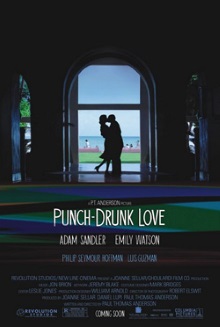
This is the last of the selections from the course list, bringing us into the modern era of Hollywood. Those who have followed along so far will note that I seem to have a skipped a couple of movies. We’ve previously watched the classic Adventures of Robin Hood and I didn’t feel it necessary to rewatch it. As for All That Heaven Allows, I’ve already written a post about it here.
The professor does seem to love romances. More than half of his selections are romantic films and Punch-Drunk Love is one of these as well. Since it seems like relatively lightweight fare, I was surprised to learn that it was directed by Paul Thomas Anderson, who directed such impressive works like There Will Be Blood and The Master. It even stars Adam Sandler, who as the leaked emails from the recent Sony hack demonstrated, is a popular target for derision due to his role in so many mediocre comedies.
Of course, the professor must have had a good reason for including this film. One clue is the use of vivid colors in the film. Sandler plays Garry Egan, the owner of a business that sells odd novelty items. When we first see him, his garish blue suit instantly stands out amidst the staid suburban industrial park that he works in. He keeps the same suit on throughout the entire movie and other characters constantly point out how distinctive and surprising it is. It’s a stylistic choice that recurs throughout the film. Instead of throwing a riot of colors onto the screen, Anderson shocks you with small splashes of vibrant color in an otherwise ordinary scene.
Together with the discordant music triggered during key moments, this use of color is meant to illustrate Egan’s inner life. From the onset, it’s clear that Egan isn’t quite normal. He suffers from terrible loneliness and feels hemmed in by his seven sisters. Under pressure and in anguish, he gives in to temper tantrums in which he violently smashes things. The colors and odd pacing from his point of view suggest he operates according to his own internal logic that other people find difficult to relate to.
Anderson’s genius here is that he uses Sandler to play a version of essentially the same character that he has played in so many of his comedies: the angry, frustrated and yet oddly lovable man-child. Those comedies are derided, especially by critics, because Sandler has played the type so many times and so shallowly that the character has gotten annoying and unsympathetic. Anderson then recognizes the essence of what Sandler does, sees that it really is a kind of mental illness and explores it more deeply, leading Punch-Drunk Love to explore darker and more dramatically satisfying territory.
The result is that unlike the completely predictable plots of the usual romantic comedies, this film keeps you constantly off-balance and guessing at what will happen next. Emily Watson plays the love interest here with assured confidence. We see that it is her patience and understanding and maybe a little bit of craziness in herself that lets her reach him when no one else can. Still, as in the case of many of these romances that take the male point of view, I can’t quite buy how she simply appears in his life in a burst of serendipity just when he needs it most.
It’s a very clever concept for a film, but it does require the audience to actually be familiar with Sandler’s body of work. There’s also no doubt that this is visually a very striking and interesting piece by a very talented director. Still, I’d rate it as only slightly above average. I simply don’t care enough about Sandler’s movies to find this deconstruction very worthwhile and without that it is a beautifully shot but still very ordinary romantic comedy.
One thought on “Punch-Drunk Love (2002)”